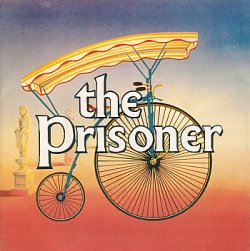
The Prisoner is a 1967 British television series created by Patrick McGoohan, with possible contributions from George Markstein. McGoohan played the lead role as Number Six, an unnamed British intelligence agent who is abducted and imprisoned in a mysterious coastal village. Episode plots have elements of science fiction, allegory, and psychological drama, as well as spy fiction. It was produced by Everyman Films for distribution by Lew Grade's ITC Entertainment.

Portmeirion is a folly tourist village in Gwynedd, North Wales. It was designed and built by Sir Clough Williams-Ellis between 1925 and 1975 in the Baroque style and is now owned by a charitable trust. The village is located in the community of Penrhyndeudraeth, on the estuary of the River Dwyryd, 2 miles (3.2 km) south east of Porthmadog, and 1 mile (1.6 km) from Minffordd railway station. Portmeirion has served as the location for numerous films and television shows, most famously as "The Village" in the 1960s television show The Prisoner.

Danger Man is a British television series that was broadcast between 1960 and 1962, and again between 1964 and 1968. The series featured Patrick McGoohan as secret agent John Drake. Ralph Smart created the programme and wrote many of the scripts. Danger Man was financed by Lew Grade's ITC Entertainment.
“The Computer Wore Menace Shoes" is the sixth episode of the twelfth season of the American animated television series The Simpsons. It first aired on the Fox network in the United States on December 3, 2000. In the episode, Homer buys a computer and creates his own website to spread gossip and fake news. However, when Homer starts writing conspiracy theories about flu shots, he is sent to an island where people who know too much are imprisoned.

Speech balloons are a graphic convention used most commonly in comic books, comics, and cartoons to allow words to be understood as representing a character's speech or thoughts. A formal distinction is often made between the balloon that indicates speech and the one that indicates thoughts; the balloon that conveys thoughts is often referred to as a thought bubble or conversation cloud.

The Village is the fictional setting of the 1960s UK television series The Prisoner where the main character, Number Six, is held with other former spies and operatives from various countries. The theme of the series is his captors' attempts to find out why Number Six resigned from his job and his attempts to escape from the Village and learn the identity of Number One. Ostensibly, those running the Village – thought by many to be countries around the world – believe that once Number Six is coerced into explaining the motive(s) behind his resignation, all the state secrets he knows will come tumbling out. However, the ultimate use of these secrets is only intimated, but not overtly explored. Beyond its explicit physical setting, the Village is also viewed as an allegory for humanity and society during the Cold War era. Patrick McGoohan notes in various post-show interviews that the Village is "within all of us...we all live in a little Village...Your village may be different from other people's villages but we are all prisoners."

"Arrival" is the first episode of the allegorical British science fiction TV series The Prisoner. It was written by George Markstein and David Tomblin, and directed by Don Chaffey. It was first broadcast in the UK on ITV on Friday 29 September 1967, and first aired in the United States on CBS on Saturday 1 June 1968.

"The Chimes of Big Ben" is an episode of the allegorical British science fiction TV series, The Prisoner. It was written by Vincent Tilsley and directed by Don Chaffey and fifth to be produced. It was the second episode to be broadcast in the UK on ITV on Friday 6 October 1967 and first aired in the United States on CBS on Saturday 8 June 1968.

"Fall Out" is the 17th and final episode of the allegorical British science fiction series The Prisoner. It was written and directed by Patrick McGoohan who also portrayed the incarcerated Number Six. The episode was first broadcast in the UK on ITV on Thursday 1 February 1968 and first aired in the United States on CBS on 21 September 1968.

"Hammer into Anvil" is an episode of the allegorical British science fiction TV series The Prisoner. It was written by Roger Woddis and directed by Pat Jackson and twelfth produced. It was the tenth episode to be broadcast in the UK on ITV on Friday 1 December 1967 and first aired in the United States on CBS on Saturday 31 August 1968.

"Free for All" is an episode of the allegorical British science fiction TV series The Prisoner. It was written and directed by Patrick McGoohan and the second episode to be produced. It was the fourth episode to be broadcast in the UK on ITV on Friday 20 October 1967 and first aired in the United States on CBS on Saturday 29 June 1968.

"Dance of the Dead" is an episode of the allegorical British science fiction TV series The Prisoner. It was written by Anthony Skene and directed by Don Chaffey and fourth to be produced. It was the eighth episode to be broadcast in the UK, on ITV on Friday 17 November 1967, and first aired in the United States on CBS on Saturday 27 July 1968.

"Checkmate" is an episode of the allegorical British science fiction TV series, The Prisoner. It was written by Gerald Kelsey and directed by Don Chaffey and third to be produced. It was the ninth episode to be broadcast in the UK on ITV on Friday 24 November 1967 and first aired in the United States on CBS on Saturday 17 August 1968.

Koichi Zenigata, usually called Inspector Zenigata and formerly Heiji Zenigata VII, is a fictional character created by Monkey Punch for his manga series Lupin III, which debuted in Weekly Manga Action on August 10, 1967. He is named after the famous fictional Japanese detective Zenigata Heiji, of whom he is a descendant.

Lupin III, referred to in some English adaptations as Arsène Lupin III, is a fictional character created by Kazuhiko Kato aka Monkey Punch as the protagonist for his manga series Lupin the Third, which debuted in Weekly Manga Action on August 10, 1967.

The Prisoner is a 2009 six-part television miniseries based on the 1960s TV series The Prisoner. The series concerned a man who awakens in a mysterious, picturesque, but escape-proof village, and stars Jim Caviezel, Sir Ian McKellen, Ruth Wilson, and Hayley Atwell. It was co-produced by American cable network AMC with British channel ITV, which now holds the rights to the original series. It received mixed reviews, with critics feeling that the remake was not as compelling as the original series.
The Prisoner, a British television series that originally ran from 1967 to 1968, has been represented in several other media.

The opening and closing sequences of the TV series The Prisoner are considered iconic. The music over the opening and closing credits, as broadcast, was composed by Ron Grainer, a composer whose other credits include the theme music for Doctor Who.
The Prisoner is a 17-episode British television series broadcast in the UK from 29 September 1967 to 1 February 1968. Starring and co-created by Patrick McGoohan, it combined spy fiction with elements of science fiction, allegory, and psychological drama. Since its debut, the series' enduring popularity has led to its influencing and being referenced in a range of other media, such as the film The Truman Show, and the television shows Lost and The X-Files. The producer of The X-Files called The Prisoner "the Gone with the Wind of its genre." The Guardian wrote that "Without The Prisoner, we'd never have had cryptic, mindbending TV series like Twin Peaks or Lost. It's the Citizen Kane of British TV – a programme that changed the landscape."
"The Riddle of the Sphinx" is the fourth episode in the second season of the HBO science fiction western thriller television series Westworld. The episode aired on May 13, 2018. It was written by Gina Atwater and Jonathan Nolan, and directed by Lisa Joy.

















